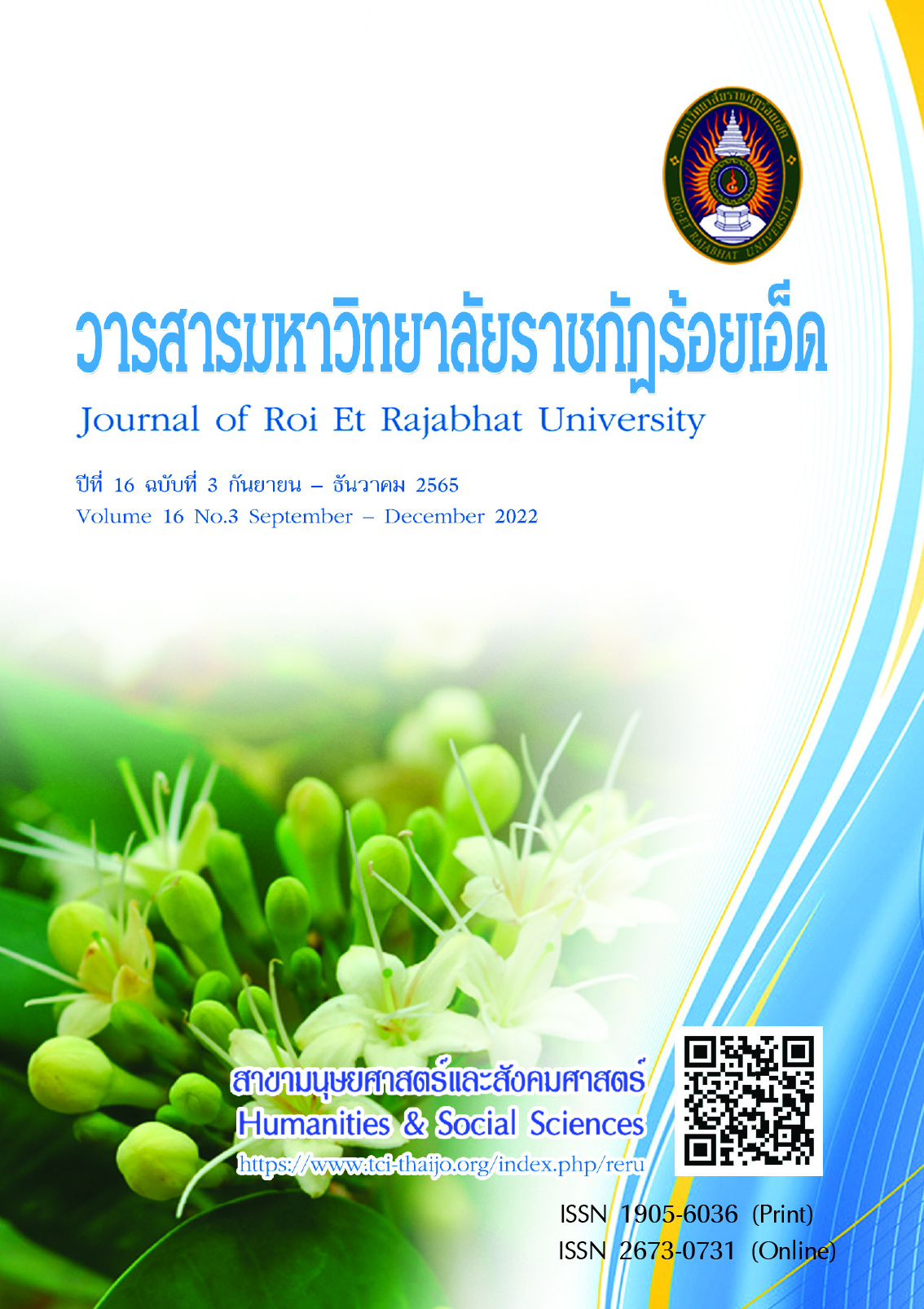The Development of Problem Solving and Analytical Thinking Abilities Using 7E Learning Cycle Model with Graphic Organizers Technique for Grade 11 Students
Keywords:
Problem solving ability, Analytical thinking ability, 7E Learning cycle model with graphic organizers techniqueAbstract
The objectives of the research were to develop problem solving and analytical thinking abilities using 7E Learning Cycle with Graphic Organizers Technique of grade 11 students. So that students would have average score not less than 70% of total score and the number of students who passed the criteria were more than 70%. The target group consisted of 20 students from 11 grade at Namphongpattanasuksa Ratchamungalapisek School, during the first semester of the 2020 academic year. The research design was action research. The research instruments were lesson plans using 7E Learning Cycle with Graphic Organizers Technique, a record form of instruction record form, a behaviour record form of teacher’s teaching and students’ learning, a student interview form, a test on the students’ mathematical problem solving ability and a test on the students’ critical thinking ability. Quantitative data were analysed by using descriptive statistics, consisting of arithmetic mean ( ), standard deviation (S.D.) and percentage (%). Qualitative data were analysed by using content analysis.
The results were summarized: 1) the students had average of problem solving ability for 24.85 or 77.86% of the total score, and there were 15 students or 75.00% passed the criteria which was higher than defined criteria. 2) The students had average of analytical thinking ability for 24.60 or 70.29% of
the total score, and there were 14 students or 70.00% passed the criteria which was higher than defined criteria.
References
กระทรวงศึกษาธิการ. (2551). หลักสูตรแกนกลางการศึกษาขั้นพื้นฐาน พุทธศักราช 2551. กรุงเทพฯ: ชุมนุมสหกรณ์การเกษตร แห่งประเทศไทย.
จุฬาลักษณ์ ภูมิปัญญา. (2550). การพัฒนาการคิดวิเคราะห์ และผลสัมฤทธิ์ทางการเรียนวิทยาศาสตร์ ของนักเรียนช่วงชั้นที่ 2 (ชั้นประถมศึกษาปีที่ 4) โดยใช้เทคนิคผังกราฟิก. วิทยานิพนธ์ ศึกษาศาสตรมหาบัณฑิต สาขาวิชาหลักสูตรและการสอน. ขอนแก่น: มหาวิทยาลัยขอนแก่น.
แรมจันทร์ พรมปากดี. (2558). การพัฒนาความสามารถในการคิดวิเคราะห์ โดยใช้การจัดการเรียนรู้แบบวัฏจักรการเรียนรู้ แบบ 7 ขั้น ร่วมกับผังกราฟิก เรื่องพันธุกรรม กลุ่มสาระการเรียนรู้วิทยาศาสตร์ ชั้นมัธยมศึกษาปีที่ 3. วิทยานิพนธ์ ครุศาสตรมหาบัณฑิต สาขาวิชาการสอนวิทยาศาสตร์. สกลนคร: มหาวิทยาลัยราชภัฏสกลนคร.
ลักษณา ศิริมาลา (2553). ความสามารถในการแก้ปัญหาและผลสัมฤทธิ์ทางการเรียนวิทยาศาสตร์ของนักเรียนชั้นมัธยมศึกษาปีที่ 1 ที่เรียนโดยใช้รูปแบบการเรียนการสอน7E. วิทยานิพนธ์ ศึกษาศาสตรมหาบัณฑิต สาขาวิชาหลักสูตรและการสอน. ขอนแก่น: มหาวิทยาลัยขอนแก่น.
ศิขรินทร์ธาร โคตรสิงห์, ประวิต เอราวรรณ์ และมนูญ ศิวารมย์. (2557). การพัฒนารูปแบบการสอนวิทยาศาสตร์โดยใช้ปัญหาเป็นฐานสำหรับพัฒนาทักษะกระบวนการคิดแก้ปัญหาของเรียนชั้นมัธยมศึกษาปีที่ 1. วิทยาการวิจัยและวิทยาการปัญญา, 11(2), 42.
สถาบันทดสอบทางการศึกษาแห่งชาติ. (2562). รายงานผลการทดสอบทางการศึกษาในระดับชาติขั้นพื้นฐาน (O-Net) ชั้นมัธยมศึกษาปีที่ 6 ปีการศึกษา 2562 รายวิชาวิทยาศาสตร์. สืบค้นเมื่อ 21 กุมภาพันธ์ 2564, จาก file:///C:/Users/Science%20nprkk/Desktop/ContentStatbySchool_2562_M6_1040042004.pdf
สิทธิพล อาจอินทร์. (2554). การพัฒนารูปแบบการจัดการเรียนรู้ที่เน้นการคิดวิเคราะห์กลุ่มสาระการเรียนรู้วิทยาศาสตร์. ขอนแก่น: มหาวิทยาลัยขอนแก่น.
สุปรียา ตันสกุล. (2540). ผลของการใช้รูปแบบการสอนแบบการจัดข้อมูลด้วยแผนภาพ ที่มีต่อสัมฤทธิผลทางการเรียน และความสามารถทางการแก้ปัญหา. ดุษฎีนิพนธ์ ครุศาสตรดุษฎีบัณฑิต สาขาวิชาจิตวิทยาการศึกษา. กรุงเทพฯ: จุฬาลงกรณ์มหาวิทยาลัย.
อังสุนีย์ สุวรรณชัย. (2557). การใช้รูปแบบการเรียนการสอน 7อี ในวิชาเคมีเพื่อส่งเสริมการคิดเชิงมโนทัศน์ของนักเรียนชั้นมัธยมศึกษาตอนปลาย. วิทยานิพนธ์ ศึกษาศาสตรมหาบัณฑิต สาขาวิชาวิทยาศาสตร์ศึกษา. เชียงใหม่: มหาวิทยาลัยเชียงใหม่.
อัจฉรา ไชยสี. (2552). ผลการจัดการเรียนรู้เรื่องระบบนิเวศของนักเรียนชั้นมัธยมศึกษาปีที่ 4 โดยใช้วัฏจักรการเรียนรู้ 7 ขั้น ร่วมกับปรัชญาเศรษฐกิจพอเพียง. วิทยานิพนธ์ ศึกษาศาสตรมหาบัณฑิต สาขาวิชาสิ่งแวดล้อมศึกษา. ขอนแก่น: มหาวิทยาลัยขอนแก่น.
Cassidy, J. (2004). Using graphic organizers to develop critical thinking. Gifted Child Today, 12(6), 34-36.
Eisenkraft, A. (2003). Expanding the 5E Model a proposed 7E modal emphasizes transfer of learning and the importance of eliciting prior understanding. The Science Teacher, 70(6), 56-59.
Kemmis, S., and McTaggart, R. (1988). The Action Research Planner (3rd ed.). Geelong, Australia: Deakin University Press.
Marzano, R. J. (2001). Designing a New Taxonomy of Educational Objective. Thousand Oaks, Califonia: Corwin Press.
Weir, J. J. (1974). Problem solving is everybody’s problem. Journal of the Science Teacher, 41(4), 16-18.
Downloads
Published
How to Cite
Issue
Section
License
Copyright (c) 2022 Roi Et Rajabhat University

This work is licensed under a Creative Commons Attribution-NonCommercial-NoDerivatives 4.0 International License.
บทความที่ได้รับการตีพิมพ์เป็นลิขสิทธิ์ของวารสารมหาวิทยาลัยราชภัฎร้อยเอ็ด
ข้อความที่ปรากฏในบทความแต่ละเรื่องในวารสารวิชาการเล่มนี้เป็นความคิดเห็นส่วนตัวของผู้เขียนแต่ละท่านไม่เกี่ยวข้องกับมหาวิทยาลัยราชภัฎร้อยเอ็ด และคณาจารย์ท่านอื่นๆในมหาวิทยาลัยฯ แต่อย่างใด ความรับผิดชอบองค์ประกอบทั้งหมดของบทความแต่ละเรื่องเป็นของผู้เขียนแต่ละท่าน หากมีความผิดพลาดใดๆ ผู้เขียนแต่ละท่านจะรับผิดชอบบทความของตนเองแต่ผู้เดียว





